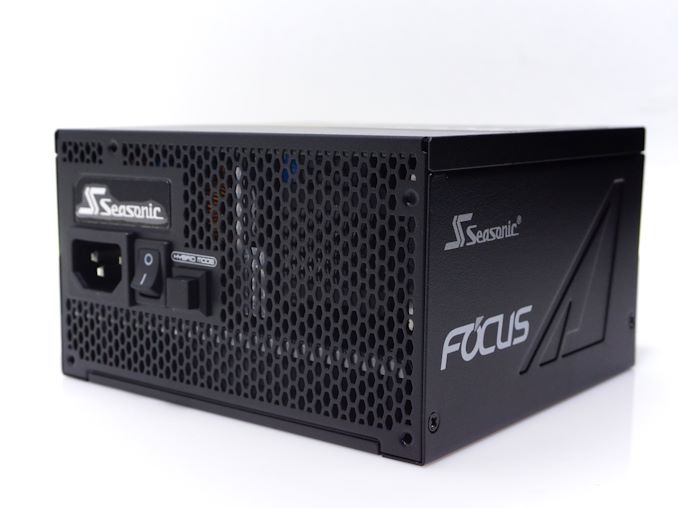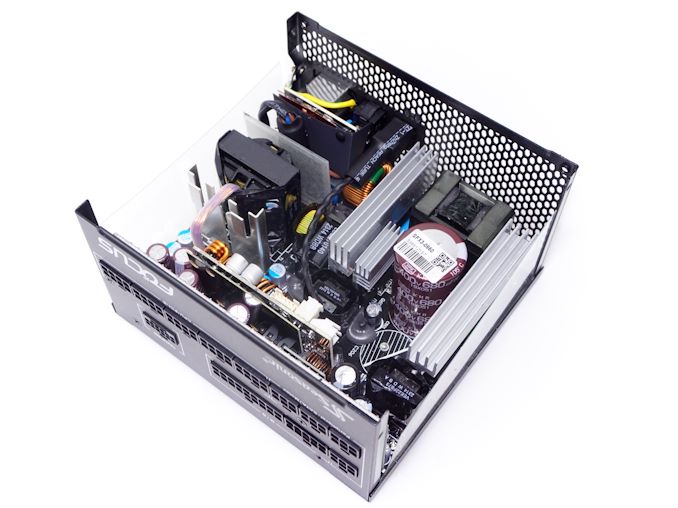The SeaSonic Focus GX-850 ATX 3.0 PSU Review: Cool, Quiet, and Robust
by E. Fylladitakis on November 29, 2023 8:00 AM EST- Posted in
- Cases/Cooling/PSUs
- Seasonic
- PSUs
- 80Plus Gold
- 850W
- ATX v3.0
- 12VHPWR
Power Supply Quality
As part of our testing, we also check output parameters are within specifications, as well as voltage ripple and line noise.
| Main Output | ||||||||
| Load (Watts) | 170.87 W | 426.55 W | 638.38 W | 850.33 W | ||||
| Load (Percent) | 20.1% | 50.18% | 75.1% | 100.04% | ||||
| Amperes | Volts | Amperes | Volts | Amperes | Volts | Amperes | Volts | |
| 3.3 V | 1.84 | 3.34 | 4.6 | 3.33 | 6.91 | 3.33 | 9.21 | 3.33 |
| 5 V | 1.84 | 5.04 | 4.6 | 5.04 | 6.91 | 5.02 | 9.21 | 5.01 |
| 12 V | 12.89 | 12.06 | 32.23 | 12.04 | 48.35 | 12.01 | 64.46 | 12 |
| Line | Regulation (20% to 100% load) |
Voltage Ripple (mV) | |||||
| 20% Load | 50% Load | 75% Load | 100% Load | CL1 12V |
CL2 3.3V + 5V |
||
| 3.3V | 0.4% | 16 | 14 | 18 | 20 | 14 | 18 |
| 5V | 0.45% | 14 | 16 | 16 | 22 | 18 | 20 |
| 12V | 0.5% | 20 | 20 | 24 | 28 | 26 | 22 |
The SeaSonic Focus GX-850 exhibits exemplary electrical performance metrics. It features tight voltage regulation on all three of its primary voltage rails (12V, 5V, and 3.3V), maintaining a regulation of less than 0.4%. The unit also boasts a low voltage ripple on the 12V rail, with a maximum recorded ripple of 28mV. In addition to this, the 3.3V and 5V rails demonstrate effective filtering, as indicated by a maximum voltage ripple of 22mV. These figures indicate a well-engineered electrical design that adheres to stringent performance criteria for a product of this class.
As part of our standard testing, we test the primary protections of all PSUs we review (Over Current, Over Voltage, Over Power, and Short Circuit). All of the protections of the SeaSonic Focus GX-850 engaged normally and within our expected parameters without any significant deviations.
Conclusion
The SeaSonic Focus GX-850 emerges as a robust ATX 3.0-compliant competitor in the crowded market of power supply units. Its build quality is exemplary, with an elegant exterior, custom embossed chassis decorations, and the convenience of fully modular cables. The internal components do not disappoint either, boasting high-grade Japanese capacitors throughout. The self-manufacture by SeaSonic ensures a meticulously designed unit, showcasing a redesigned Focus series platform aimed at ATX 3.0 compliance. The compact and clean design further accentuates its aesthetic and functional appeal while ensuring compatibility with all ATX-compliant cases.
Performance-wise, the Focus GX-850 excels in power quality. It exhibits remarkable voltage filtering, keeping the voltage ripples restrained below 28 mV even under strenuous loads. The load regulation is tight, with a variance of less than 0.5% on all voltage rails, showcasing its ability to deliver stable power under different load scenarios. Additionally, it comfortably meets the 80Plus Gold efficiency requirements, marginally missing the 80Plus Platinum certification at maximum load.
On the thermal front, the unit fares well with commendable thermal performance characterized by relatively low operating temperatures, a feature attributable to its high efficiency. Despite its substantial power output, the PSU maintains a cool operation, vital for long-term reliability and optimal performance. The noise level is another aspect where the Focus GX-850 shines; it operates nearly silently at low loads and room temperature. Although the noise level ascends with increased load, it remains within a tolerable range for most users.
The value proposition of the Focus GX-850 is somewhat nuanced. SeaSonic has undeniably elevated the performance metrics in the new Focus GX series over the preceding Focus Plus units. However, the current retail price of $168 positions it at a higher bracket compared to other 80Plus Gold certified ATX 3.0 units, never mind the $40 cheaper pre-ATX 3.0 version of the GX. The superior build quality and a reassuring 10-year warranty do provide some level of offset to the cost, but the heavy market competition due to a plethora of comparable products at or below its price point could pose a challenge for prospective buyers.
Ultimately, the SeaSonic Focus GX-850 ATX 3.0 is a formidable contender for those seeking a blend of quality, performance, and reliability, albeit at a premium price.












24 Comments
View All Comments
meacupla - Friday, December 1, 2023 - link
I'd hate it if I bought a PSU for a media server and it didn't come with at least 8 SATA power connectors.mariush - Monday, December 4, 2023 - link
3.3v is still used by m,2 drives on your motherboard, and it's also present in pci-e slots (up to 10 watts, and in theory used in sleep/stand-by mode by video cards). 3.3v or 5v is also often used by motherboards to produce the voltage required by RAM to work using a dc-dc converter (3.3v or 5v down to 1v...1.65v). 5v is still used by USB ports, chipsets, some onboard devices.A motherboard manufacturer could produce 5v and 3.3v on the motherboard using dedicated dc-dc converter circuits like the ones for CPU and RAM, but would increase the cost of the motherboard. They would also have to include a ATX 24 pin to ATX 12V0 only adapter cable and risk people not buying the motherboard because they don't like the adapter cable or because they avoid the motherboard simply because they don't see the big 24 pin connector in the picture of the board and don't bother to read the description.
Catweazle - Monday, December 11, 2023 - link
Wait, do you really think your CPU, RAM and other chips run on 12 volts? Because they don't. All of those voltages are absolutely necessary, they are not obsolete at all.evanh - Tuesday, December 12, 2023 - link
CPU and RAM don't use any of the supplied voltages directly. They are both converted down to around 1 to 2 volts in the motherboard. The CPU has a dedicate 12 volt plug for just this - Originally introduced for the Pentium4 in year 2000.evanh - Wednesday, November 29, 2023 - link
I don't see any mention of whether the 12VHPWR plug has been updated to a 12V-2x6 plug. The implication is it's still using the old flawed plug.Ryan Smith - Thursday, November 30, 2023 - link
There aren't any PSUs currently available with 12V-2x6. That'll be a 2024 thing.evanh - Thursday, November 30, 2023 - link
Shouldn't there already be an industry wide recall of the 12VHPWR plugs? They are all ticking time bombs for wrecking graphics cards and even a fire hazard.evanh - Thursday, November 30, 2023 - link
Here's one that is stating it has been upgraded - https://www.techpowerup.com/315317/thermaltake-unv...Ryan Smith - Thursday, November 30, 2023 - link
The Thermaltake unit is not yet available for sale. They did technically say this month, but as today's the last day of the month, I don't expect they'll make it.It's going to take some time to start including the new cables. Large PSU inventories make for quite a buffer.
evanh - Thursday, November 30, 2023 - link
Given the existing 12VHPWR cables should all be on an immediate recall, I can't see inventory being any excuse at all.